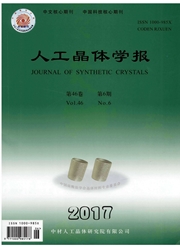

 中文摘要:
中文摘要:
采用扫描红外显微镜、光学显微镜、电感耦合等离子质谱仪和微波光电导衰减仪对铜杂质在多晶硅中不同缺陷状态区域的沉淀和吸杂行为进行研究。发现铜杂质沉淀行为与缺陷密度密切相关,在低缺陷密度区域铜杂质大多易于均质形核形成沉淀,而在高缺陷密度区域铜杂质通常会聚集在缺陷处异质形核而沉淀下来。当铜沾污量较高时,由于在硅基体中的肖特基二极管效应,铜沉淀会令多晶硅中的载流子寿命明显缩短。在900℃下进行快速磷吸杂处理后,这两种区域中的铜杂质都不能得到有效去除。
 英文摘要:
英文摘要:
The precipitation and gettering behaviors of copper (Cu) at different defective regions in multicrystalline silicon were investigated by combining scanning infrared microscopy, optical microscopy, inductively coupled plasma mass spectrometry and microwave photo-conductance decay. It is found that the behaviors of Cu precipitation are strongly dependent on the defect density. Most of the Cu contaminants tend to form precipitates homogeneously in the low density defect region, while they mostly segregate at the defects and form precipitates heterogeneously in the high density defect region. In the case of heavy contamination, the Cu precipitate can significantly reduce the carrier lifetime of multicrystalline silicon due to their Schottkydiode behavior in the silicon substrate. A 900 °C rap thermal process (RTP) phosphorus gettering anneal cannot be sufficiently effective to remove the Cu precipitates in these two regions.
 同期刊论文项目
同期刊论文项目
 同项目期刊论文
同项目期刊论文
 Retarded oxygen diffusion in heavily phosphorus-doped Czochralski silicon: Experiments and first-pri
Retarded oxygen diffusion in heavily phosphorus-doped Czochralski silicon: Experiments and first-pri Seed-assisted cast quasi-single crystalline silicon for photovoltaic application: Towards high effic
Seed-assisted cast quasi-single crystalline silicon for photovoltaic application: Towards high effic Internal gettering for germanium-doped Czochralski silicon: Treated by rapid-thermal-anneal based pr
Internal gettering for germanium-doped Czochralski silicon: Treated by rapid-thermal-anneal based pr Modulation of atomic-layer-deposited Al2O3 film passivation of silicon surface by rapid thermal proc
Modulation of atomic-layer-deposited Al2O3 film passivation of silicon surface by rapid thermal proc The modulation of surface texture for single-crystalline Si solar cells using calibrated silver nano
The modulation of surface texture for single-crystalline Si solar cells using calibrated silver nano The effect of impurity-induced lattice strain and Fermi level position on low temperature oxygen dif
The effect of impurity-induced lattice strain and Fermi level position on low temperature oxygen dif Effect of nickel contamination on grain boundary states at a direct silicon bonded (1 1 0)/(1 0 0) i
Effect of nickel contamination on grain boundary states at a direct silicon bonded (1 1 0)/(1 0 0) i Immobilization of dislocations by oxygen precipitates in Czochralski silicon: Feasibility of precipi
Immobilization of dislocations by oxygen precipitates in Czochralski silicon: Feasibility of precipi Impact of silicon substrate germanium doping on diode characteristics and on thermal donor formation
Impact of silicon substrate germanium doping on diode characteristics and on thermal donor formation Comparison of electron irradiation effects on diodes fabricated on silicon and on germanium doped si
Comparison of electron irradiation effects on diodes fabricated on silicon and on germanium doped si Effects of high temperature rapid thermal processing on oxygen precipitation in heavily arsenic-dope
Effects of high temperature rapid thermal processing on oxygen precipitation in heavily arsenic-dope Light-induced degradation in n-type Czochralski silicon by boron-doping and thermal donor compensati
Light-induced degradation in n-type Czochralski silicon by boron-doping and thermal donor compensati First-principles study on the surface chemistry of 1.4 nm silicon nanocrystals: Case of hydrosilylat
First-principles study on the surface chemistry of 1.4 nm silicon nanocrystals: Case of hydrosilylat Influence of the compensation level on the performance of p-type crystalline silicon solar cells: Th
Influence of the compensation level on the performance of p-type crystalline silicon solar cells: Th Effect of nickel contamination on grain boundary states at a direct silicon bonded (110)/(100) inter
Effect of nickel contamination on grain boundary states at a direct silicon bonded (110)/(100) inter Modulation of 1.5 um dislocation-related luminescence emitted from a direct silicon bonded interface
Modulation of 1.5 um dislocation-related luminescence emitted from a direct silicon bonded interface Effect of iron contamination on grain boundary states at a direct silicon bonded (110)/(100) interfa
Effect of iron contamination on grain boundary states at a direct silicon bonded (110)/(100) interfa Suppression of boron-oxygen defects in p-type Czochralski silicon by germanium doping (vol 97, 05190
Suppression of boron-oxygen defects in p-type Czochralski silicon by germanium doping (vol 97, 05190 Phosphorus gettering of precipitated Cu in single crystalline silicon based on rapid thermal process
Phosphorus gettering of precipitated Cu in single crystalline silicon based on rapid thermal process Effect of germanium on the kinetics of boron-oxygen defect generation and dissociation in Czochralsk
Effect of germanium on the kinetics of boron-oxygen defect generation and dissociation in Czochralsk Low-cost solar grade silicon purification process with Al-Si system using a powder metallurgy techni
Low-cost solar grade silicon purification process with Al-Si system using a powder metallurgy techni Quantification of characteristic parameters for the dissociation kinetics of iron-boron pairs in Czo
Quantification of characteristic parameters for the dissociation kinetics of iron-boron pairs in Czo Hydrogen passivation of Fe-related deep energy levels at a direct silicon-bonded (110)/(100) grain b
Hydrogen passivation of Fe-related deep energy levels at a direct silicon-bonded (110)/(100) grain b Formation of shallow junctions in gallium and phosphorus compensated silicon for cell performance im
Formation of shallow junctions in gallium and phosphorus compensated silicon for cell performance im 期刊信息
期刊信息
